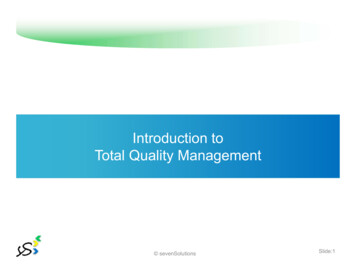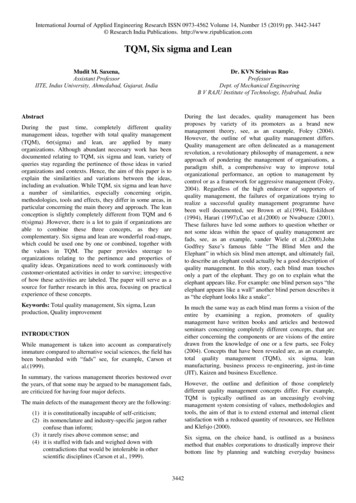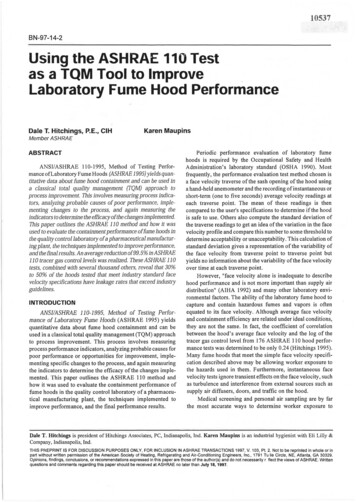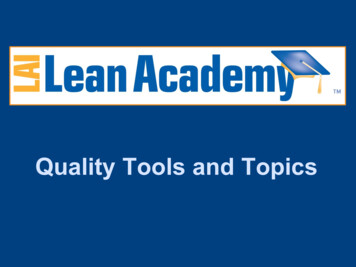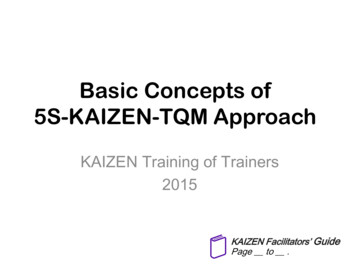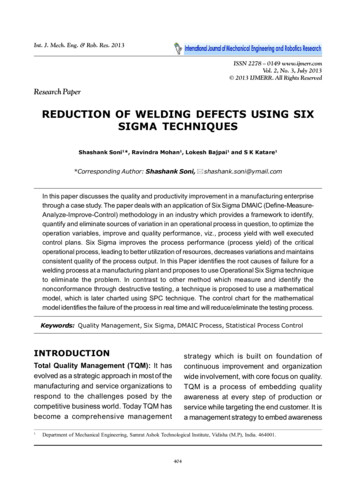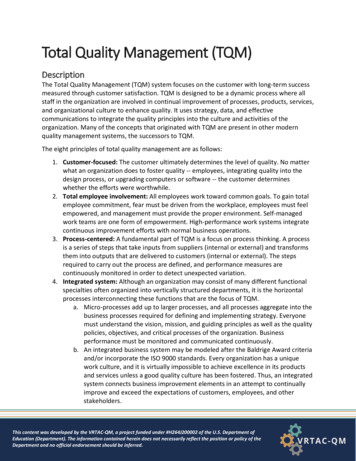
Transcription
Total Quality Management (TQM)DescriptionThe Total Quality Management (TQM) system focuses on the customer with long-term successmeasured through customer satisfaction. TQM is designed to be a dynamic process where allstaff in the organization are involved in continual improvement of processes, products, services,and organizational culture to enhance quality. It uses strategy, data, and effectivecommunications to integrate the quality principles into the culture and activities of theorganization. Many of the concepts that originated with TQM are present in other modernquality management systems, the successors to TQM.The eight principles of total quality management are as follows:1. Customer-focused: The customer ultimately determines the level of quality. No matterwhat an organization does to foster quality -- employees, integrating quality into thedesign process, or upgrading computers or software -- the customer determineswhether the efforts were worthwhile.2. Total employee involvement: All employees work toward common goals. To gain totalemployee commitment, fear must be driven from the workplace, employees must feelempowered, and management must provide the proper environment. Self-managedwork teams are one form of empowerment. High-performance work systems integratecontinuous improvement efforts with normal business operations.3. Process-centered: A fundamental part of TQM is a focus on process thinking. A processis a series of steps that take inputs from suppliers (internal or external) and transformsthem into outputs that are delivered to customers (internal or external). The stepsrequired to carry out the process are defined, and performance measures arecontinuously monitored in order to detect unexpected variation.4. Integrated system: Although an organization may consist of many different functionalspecialties often organized into vertically structured departments, it is the horizontalprocesses interconnecting these functions that are the focus of TQM.a. Micro-processes add up to larger processes, and all processes aggregate into thebusiness processes required for defining and implementing strategy. Everyonemust understand the vision, mission, and guiding principles as well as the qualitypolicies, objectives, and critical processes of the organization. Businessperformance must be monitored and communicated continuously.b. An integrated business system may be modeled after the Baldrige Award criteriaand/or incorporate the ISO 9000 standards. Every organization has a uniquework culture, and it is virtually impossible to achieve excellence in its productsand services unless a good quality culture has been fostered. Thus, an integratedsystem connects business improvement elements in an attempt to continuallyimprove and exceed the expectations of customers, employees, and otherstakeholders.This content was developed by the VRTAC-QM, a project funded under #H264J200002 of the U.S. Department ofEducation (Department). The information contained herein does not necessarily reflect the position or policy of theDepartment and no official endorsement should be inferred.
5. Strategic and systematic approach: A critical part of the management of quality is thestrategic and systematic approach to achieving an organization’s vision, mission, andgoals. This process, called strategic planning or strategic management, includes theformulation of a strategic plan that integrates quality as a core component.6. Continual improvement: A core aspect of TQM is continual process improvement.Continual improvement drives an organization to be both analytical and creative infinding ways to become more competitive and more effective at meeting stakeholderexpectations.7. Fact-based decision-making: In order to know how well an organization is performing,data on performance measures are necessary. TQM requires that an organizationcontinually collect and analyze data in order to improve decision making accuracy,achieve consensus, and project future outcomes based on past history.8. Communications: During times of organizational change, as well as part of day-to-dayoperation, effective communications is crucial in maintaining morale and in motivatingemployees at all levels. Communications involve strategies, method, and timeliness.These principles are considered so essential to TQM that many organizations define them, insome format, as a set of core values. The methods for implementing this approach come fromthe teachings of Philip B. Crosby, W. Edwards Deming, Armand V. Feigenbaum, Kaoru Ishikawa,and Joseph M. Juran.BackgroundThe history of total quality management (TQM) began initially as a term coined by the Naval AirSystems Command to describe its Japanese-style management approach to qualityimprovement. In the 1920s, some of the first seeds of quality management were planted as theprinciples of scientific management and swept through U.S. industry. Businesses clearlyseparated the processes of planning and carrying out the plan, and union opposition arose asworkers were deprived of a voice in the conditions and functions of their work. The Hawthorneexperiments in the late 1920s showed how worker productivity could be impacted byparticipation in management. In the 1930s, Walter Shewhart developed the methods forstatistical analysis and control of quality which informed future the work of Dr. EdwardsDeming and Joseph M. Juran who are considered the founders of TQM.In the 1940s, during World War II, quality became more statistical in nature. Statistical samplingtechniques were used to evaluate quality, and quality control charts were used to monitor theproduction process. In the 1950s, Deming taught methods for statistical analysis and control ofquality to Japanese engineers and executives. This can be considered the origin of TQM. Jurantaught the concepts of controlling quality and managerial breakthrough. Armand V.Feigenbaum's book Total Quality Control, a forerunner for the present understanding of TQM,was published. Philip B. Crosby's promotion of zero defects paved the way for qualityimprovement in many companies.This content was developed by the VRTAC-QM, a project funded under #H264J200002 of the U.S. Department ofEducation (Department). The information contained herein does not necessarily reflect the position or policy of theDepartment and no official endorsement should be inferred.
Deming was an American engineer, statistician, and professor. He helped develop the samplingtechniques still used by the U.S. Department of the Census and the Bureau of Labor Statistics.After WWII, in 1950, he worked with Japanese industry leaders (engineers and executives). Hedelivered speeches on what he called "Statistical Product Quality Administration" whichfocused on methods for statistical analysis and control. This can be considered the origin ofTQM. Deming went on to develop his 14 Points and his system of thought he called the "Systemof Profound Knowledge."Juran was an engineer who taught the concepts of controlling quality and managerialbreakthrough. The first edition of Juran's Quality Control Handbook in 1951 attracted theattention of the Japanese Union of Scientists and Engineers, which invited him to Japan in 1952.Operating independently of Deming, he worked with executives from 10 manufacturingcompanies on managing for quality. Juran is widely credited for adding the human dimension toquality management. He pushed for the education and training of managers. For Juran, humanrelations problems were the ones to isolate, and resistance to change was the root cause ofquality issues. His concept of quality management extended outside the walls of the factory toencompass nonmanufacturing processes, especially those that might be thought of as servicerelated.In the 1960s, with the help of individuals like Deming and Juran, the concept took on a broadermeaning. Quality began to be viewed as something that encompassed the entire organization,not only the production process. Since all functions were responsible for product quality and allshared the costs of poor quality, quality was seen as a concept that affected the entireorganization. In 1968, the Japanese named their approach to total quality "companywide qualitycontrol." It is around this time that the term quality management systems emerged. KaoruIshikawa's synthesis of the philosophy contributed to Japan's ascendancy as a quality leader.In 1981, Ford Motor Company was one of the first American corporations to seek help fromDeming. He attributed the decline in sales to management and not quality issues. By 1986, Fordhad become the most profitable American auto company which they attributed to Deming’steachings. In 1982, Edwards Deming, Paul Hertz, and Howard Gitlow founded the W. EdwardsDeming Institute for the Improvement of Productivity and Quality. In 1983, the institute trainedconsultants of Ernst and Whinney Management Consultants who went on to found the DemingQuality Consulting Practice.In the 1980s and 1990s, the name Total Quality Management (TQM) emerged as a new phaseof quality control and management began. Having observed Japan’s success of employingquality issues, western companies started to introduce their own quality initiatives. TQM,developed as a catchall phrase for the broad spectrum of quality-focused strategies, programs,and techniques during this period. In 1988, a major step forward in quality management wasmade with the development of the Malcolm Baldrige Award in the United States. The model, onwhich the award was based, represented the first clearly defined and internationally recognizedTQM model. It was developed by the United States government to encourage companies toadopt the model and improve their competitiveness.This content was developed by the VRTAC-QM, a project funded under #H264J200002 of the U.S. Department ofEducation (Department). The information contained herein does not necessarily reflect the position or policy of theDepartment and no official endorsement should be inferred.
TQM is now the name for the philosophy of a broad and systemic approach to managingorganizational quality. Quality standards such as the ISO 9000 series and quality awardprograms such as the Deming Prize and the Malcolm Baldrige National Quality Award specifyprinciples and processes that comprise TQM. TQM as a term to describe an organization'squality policy and procedure has fallen out of favor as international standards for qualitymanagement have been developed. An umbrella methodology for continually improving thequality of all processes, it draws on a knowledge of the principles and practices of the following: The behavioral sciences;The analysis of quantitative and nonquantitative data;Economics theories; andProcess analysisTQM models are often called Business Excellence Models. Also, TQM itself is now often calledBusiness Excellence. This is to distinguish the “new TQM” from the past work on TQM.Intersection with Other Quality Management SystemsImprints of TQM concepts can be found in modern approaches to quality management, such asthe Malcolm Baldrige National Quality Award (MBNQA) criteria, ISO 9001, Six Sigma, and leanmanufacturing.Diagram: Intersection of TQM with other Quality Management SystemsThis content was developed by the VRTAC-QM, a project funded under #H264J200002 of the U.S. Department ofEducation (Department). The information contained herein does not necessarily reflect the position or policy of theDepartment and no official endorsement should be inferred.
PurposeDeming taught that by adopting appropriate principles of management, organizations canincrease quality and simultaneously reduce costs (by reducing waste, rework, staff attrition,and litigation while increasing customer loyalty). The key is to practice continual improvementand think of manufacturing as a system, not as bits and pieces. The goal of total qualitymanagement is to garner optimal customer satisfaction. The benefits to adopting the systemare as follows: Strengthened competitive positionAdaptability to changing or emerging market conditions and to environmental and othergovernment regulationsHigher productivityEnhanced market imageElimination of defects and wasteReduced costs and better cost managementHigher profitabilityImproved customer focus and satisfactionIncreased customer loyalty and retentionIncreased job securityImproved employee moraleEnhanced shareholder and stakeholder valueImproved and innovative processesHow It WorksGeneric Strategy Model for Implementing TQM Systems1. Top management learns about and decides to commit to TQM. TQM is identified as oneof the organization’s strategies.2. The organization assesses current culture, customer satisfaction, and qualitymanagement systems.3. Top management identifies core values and principles to be used and communicatesthem.4. A TQM master plan is developed based on steps 1, 2, and 3.5. The organization identifies and prioritizes customer demands and aligns products andservices to meet those demands.6. Management maps the critical processes through which the organization meets itscustomers’ needs.7. Management oversees the formation of teams for process improvement efforts.8. The momentum of the TQM effort is managed by the steering committee.9. Managers contribute individually to the effort through hoshin planning, training,coaching, or other methods.This content was developed by the VRTAC-QM, a project funded under #H264J200002 of the U.S. Department ofEducation (Department). The information contained herein does not necessarily reflect the position or policy of theDepartment and no official endorsement should be inferred.
10. Daily process management and standardization take place.11. Progress is evaluated and the plan is revised as needed.12. Constant employee awareness and feedback on status are provided and areward/recognition process is established.Core Values, Principles and ConceptsW. Edwards Deming’s 14 Points for Total Quality Management, or the Deming Model of QualityManagement, a core concept on implementing total quality management (TQM), is a set ofmanagement practices to help companies increase their quality and productivity.Deming's 14 Points for TQM1. Create constancy of purpose for improving products and services.2. Adopt the new philosophy.3. Cease dependence on inspection to achieve quality.4. End the practice of awarding business on price alone; instead, minimize total cost byworking with a single supplier.5. Improve constantly and forever every process for planning, production, and service.6. Institute training on the job.7. Adopt and institute leadership.8. Drive out fear.9. Break down barriers between staff areas.10. Eliminate slogans, exhortations, and targets for the workforce.11. Eliminate numerical quotas for the workforce and numerical goals for management.12. Remove barriers that rob people of pride of workmanship and eliminate the annualrating or merit system.13. Institute a vigorous program of education and self-improvement for everyone.14. Put everybody in the company to work accomplishing the transformation.These total quality management principles can be put into place by any organization toimplement total quality management more effectively. As a total quality managementphilosophy, Dr. Deming’s work is foundational to TQM and its successor, quality managementsystems.This content was developed by the VRTAC-QM, a project funded under #H264J200002 of the U.S. Department ofEducation (Department). The information contained herein does not necessarily reflect the position or policy of theDepartment and no official endorsement should be inferred.
FrameworkDiagram: Total Quality Management (TQM) Framework: Key ElementsApplicationStrategy 1: The TQM element approach takes key business processes and uses the tools of TQMto foster improvements. This method was widely used in the early 1980s as companies tried toimplement parts of TQM as they learned them. Examples of this approach include qualitycircles, statistical process control, Taguchi methods, and quality function deployment.Strategy 2: The guru approach uses the teachings and writings of one or more of the leadingquality thinkers as a guide against which to determine where the organization has deficiencies.The organization makes appropriate changes to remedy those deficiencies. For example,managers might study Deming’s 14 points or attend the Crosby College. Afterward, they wouldwork on implementing the approach learned.Strategy 3: In the organization model approach, individuals or teams visit organizations thathave taken a leadership role in TQM and determine their processes and reasons for success.They then integrate these ideas with their own ideas to develop an organizational modeladapted for their specific organization. This method was used widely in the late 1980s and isexemplified by the initial recipients of the Malcolm Baldrige National Quality Award.This content was developed by the VRTAC-QM, a project funded under #H264J200002 of the U.S. Department ofEducation (Department). The information contained herein does not necessarily reflect the position or policy of theDepartment and no official endorsement should be inferred.
Strategy 4: Organizations using the Japanese total quality approach examine the detailedimplementation techniques and strategies employed by Deming Prize-winning companies anduse this experience to develop a long-range master plan for in-house use. This approach wasused by Florida Power and Light, among others, to implement TQM and to compete for, andwin, the Deming Prize.Strategy 5: When using award criteria model, an organization uses the criteria of a qualityaward (e.g., the Deming Prize, the European Quality Award, or the Malcolm Baldrige NationalQuality Award) to identify areas for improvement. Under this approach, TQM implementationfocuses on meeting specific award criteria. Although some argue that this is not an appropriateuse of award criteria, some organizations do use this approach and it can result inimprovement.Vocational RehabilitationThere is some evidence that Total Quality Management has been used by Government andHuman Service Organizations. To the best of our knowledge, no VR agencies are using thismodel. Various VR agencies have implemented Lean Six Sigma and the Malcolm Baldrige Modelof Performance Excellence framework which share similar standards and principles.Other OrganizationsDeming’s teachings and Total Quality Management methods have had broad influence onorganizations like the U.S. Environmental Protection Agency, Vernay Laboratories, and MarshallIndustries. With the growing maturity of society with respect to education, culture andstandards of living, the service sector demands for improved quality of service are increasing.This is part of the pressure causing service organizations to explore TQM as a means of drivingquality improvement into all their activities. (Source: TQM in the service sector, Mohanty, 1996.)Criticisms or ConcernsWhile TQM is considered an effective quality management system, it has garnished criticism onseveral aspects. TQM is a time-consuming process as it involves proper evaluation of theprocess of manufacturing a product or service. This is not atypical of other models, and for anyreal systematic change, an organization needs to remain committed and be realistic that not allchanges will occur immediately. Another cited critique is that it can be costly to maintain thequality of the product. It requires the cost of training the employees, improving theinfrastructure of the organization, charges of the consultancy firm to aid in improving quality.Lastly, some argue that there is a danger of hindering creativity and innovation. If anorganization focuses on the satisfaction of the customer only and the product satisfies theneeds of the customer, then it is not necessary, that the innovative product will also satisfy.Thus, the management cannot use creative ideas as it may result in losing the customer.This content was developed by the VRTAC-QM, a project funded under #H264J200002 of the U.S. Department ofEducation (Department). The information contained herein does not necessarily reflect the position or policy of theDepartment and no official endorsement should be inferred.
EffectivenessResults from research shows that the core principles of Total Quality Management are widelyimplemented in manufacturing industries. Despite this, many employees don’t have a clear ideaof what Total Quality Management is, and that the more successful industries tend to havemore deep knowledge and usage of the TQM principles. These companies may get benefit bygiving time to fully understand TQM concept and can use it to its fullest potential.Recommendation for Use In VRWith the established process established by law and regulation for the public vocationalrehabilitation program, where individuals move through referral, application, and eligibility toassessment, planning and service delivery and on to employment placement, monitoring andeventual closure, all under the umbrella counseling and guidance, TQM as a qualityimprovement model has efficacy worthy of consideration. Its operational structure may meetan agency’s needs as a stand-alone approach to improving quality management, or incombination with other complimentary quality management models (ISO 900 or Baldridge, forexample).CertificationManager of Quality/Organizational Excellence Certification - CMQ/OE: The certification isintended for professionals who lead and champion process-improvement initiatives,everywhere from small businesses to multinational corporations. These individuals lead teamefforts to establish and monitor customer/supplier relations, supports strategic planning anddeployment initiatives, and helps develop measurement systems to determine organizationalimprovement. They will also motivate and evaluate staff, manage projects and humanresources, analyze financial situations, determine and evaluate risk, and employ knowledgemanagement tools and techniques in resolving organizational challenges.CoursesQuality 101: This course teaches concepts like the seven basic quality tools to improveprocesses and increase your organization’s operational efficiency.Integrated Quality Management: This course teaches how to integrate quality managementinto your organization’s processes. You’ll leave this course with a draft action plan customizedto fit the needs of your business. These concepts are applicable to a wide range of industries,including manufacturing, service, education, and healthcare.Certified Manager of Quality/Organizational Excellence Certification Preparation: This course isa certification preparation course for individuals preparing to take the ASQ Certified Manager ofQuality/Organizational Excellence examination.This content was developed by the VRTAC-QM, a project funded under #H264J200002 of the U.S. Department ofEducation (Department). The information contained herein does not necessarily reflect the position or policy of theDepartment and no official endorsement should be inferred.
ResourcesWebsitesTotal Quality Management in HR: ent/articles/total-quality-management-in-hrBooks The Certified Manager of Quality/Organizational Excellence HandbookFrom Quality to Business Excellence: A Systems Approach to ManagementJuran, Quality, and a Century of ImprovementInsights to Performance Excellence 2019-2020Total Quality Management in Human Service OrganizationsArticlesA Preview of Total Quality Management (TQM) in Public Services: Total Management System orTotal Quality Management (TQM) is a management system that focuses on the Customer byinvolving all levels of employees in upgrading or continuous improvement. Total QualityManagement used data and effective communication to integrate his discipline into the cultureand quality of company activities. In short, Total Quality Management (TQM) is a managementapproach to achieve long- term success through customer satisfaction. This study had twoobjectives. The first objective was to examine challenges when implementing TQM in publicorganizations. The second objective was to argues that TQM brings good implications to publicservices to enhance service quality.Why and How TQM Leads to Performance Improvements (Quality Management Journal)Evidence shows that TQM improves organizational performance, but researchers disagree onwhy and how such improvements occur and on who really benefits. This study tests hypothesesrelating to TQM adoption and the path from wealth creation to wealth appropriation.The Relationship Between ISO 9000 Certification, TQM Practices, And OrganizationalPerformance (Quality Management Journal) There is no consensus among the researchcommunity about the relationship between ISO 9000 certification and TQM, and the effect ofeach of these quality management practices on organizational performance is still debated. Thispaper developed a conceptual model to study the relationships between ISO 9000 certification,TQM practices, and organizational performance.The Role of Strategic Planning in Implementing a Total Quality Management Framework: AnEmpirical View (Quality Management Journal) This empirical study examines the significant roleof strategic planning as an important dimension in successfully implementing TQM andconfirming that strategic planning is likewise extremely important.This content was developed by the VRTAC-QM, a project funded under #H264J200002 of the U.S. Department ofEducation (Department). The information contained herein does not necessarily reflect the position or policy of theDepartment and no official endorsement should be inferred.
Total Quality Management in Government: A Practical Guide for the Real World by StevenCohen, Ronald Brand. Journal of Public Administration Research and Theory: J-PART, Vol. 4, No.1, The Berkeley Symposium on Public Management (Jan. 1994), pp. 93-98 (6 pages) Publishedby: Oxford University Press.VideosTQM: The History and the Now (ASQTV). This episode explores total quality management’sbeginnings and how it’s used to build and sustain a culture of quality today.This content was developed by the VRTAC-QM, a project funded under #H264J200002 of the U.S. Department ofEducation (Department). The information contained herein does not necessarily reflect the position or policy of theDepartment and no official endorsement should be inferred.
Total Quality Management (TQM) Description The Total Quality Management (TQM) system focuses on the customer with long-term success measured through customer satisfaction. TQM is designed to be a dynamic process where all staff in the organization are involved i
